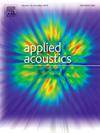The influence of thermoacoustic effect and microstructure parameters on acoustic performance of porous ceramic fiber material
IF 3.4
2区 物理与天体物理
Q1 ACOUSTICS
引用次数: 0
Abstract
Based on the principles of linear thermoacoustic theory and the impedance tube model, this study investigates the influence of temperature distribution and microstructural parameters on the sound absorption performance of porous ceramic fiber materials. The equivalent parameters of the linear thermoacoustic theory were obtained by using the reconstructed 3D random microstructure model and JCAPL model. Then the impedance tube model was established to calculate the sound absorption coefficient of the porous fiber material under the uneven temperature field. The results show that the influence of thermoacoustic effect on the sound absorption coefficient is mainly in the middle and low frequency, and the influence amplitude is extremely dependent on the frequency. When the temperature gradient is 20 K/mm, the absorption coefficient will reach the minimum value of −5.53 at 90 Hz. At 290 Hz, the absorption coefficient reaches 0.88, which is 17.6 times higher than 0.05 when the thermoacoustic effect is not considered. The influence of the thermoacoustic effect on the absorption coefficient decreases as the interface temperature increases. Conversely, the impact of the thermoacoustic effect intensifies with a greater absolute value of the temperature gradient. When the temperature gradient is negative, the sound absorption coefficient becomes negative in the mid and low frequency ranges. Additionally, a reduction in porosity and fiber radius leads to an increased influence of the thermoacoustic effect on the absorption coefficient. The influence of the thermoacoustic effect diminishes as the fiber orientation angle approaches 0°.
热声效应和微观结构参数对多孔陶瓷纤维材料声学性能的影响
基于线性热声理论原理和阻抗管模型,研究了温度分布和微观结构参数对多孔陶瓷纤维材料吸声性能的影响。利用重建的三维随机微观结构模型和JCAPL模型,得到了线性热声理论的等效参数。然后建立阻抗管模型,计算非均匀温度场下多孔纤维材料的吸声系数。结果表明,热声效应对吸声系数的影响主要集中在中低频,且影响幅度对频率的依赖性极大。当温度梯度为20k /mm时,在90hz时吸收系数最小,为−5.53。在290 Hz时,吸收系数达到0.88,比不考虑热声效应时的0.05高17.6倍。热声效应对吸收系数的影响随界面温度的升高而减小。相反,热声效应的影响随着温度梯度绝对值的增大而增强。当温度梯度为负时,在中低频范围内吸声系数为负。此外,孔隙率和纤维半径的减小导致热声效应对吸收系数的影响增加。当纤维取向角接近0°时,热声效应的影响逐渐减弱。
本文章由计算机程序翻译,如有差异,请以英文原文为准。
求助全文
约1分钟内获得全文
求助全文
来源期刊

Applied Acoustics
物理-声学
CiteScore
7.40
自引率
11.80%
发文量
618
审稿时长
7.5 months
期刊介绍:
Since its launch in 1968, Applied Acoustics has been publishing high quality research papers providing state-of-the-art coverage of research findings for engineers and scientists involved in applications of acoustics in the widest sense.
Applied Acoustics looks not only at recent developments in the understanding of acoustics but also at ways of exploiting that understanding. The Journal aims to encourage the exchange of practical experience through publication and in so doing creates a fund of technological information that can be used for solving related problems. The presentation of information in graphical or tabular form is especially encouraged. If a report of a mathematical development is a necessary part of a paper it is important to ensure that it is there only as an integral part of a practical solution to a problem and is supported by data. Applied Acoustics encourages the exchange of practical experience in the following ways: • Complete Papers • Short Technical Notes • Review Articles; and thereby provides a wealth of technological information that can be used to solve related problems.
Manuscripts that address all fields of applications of acoustics ranging from medicine and NDT to the environment and buildings are welcome.
 求助内容:
求助内容: 应助结果提醒方式:
应助结果提醒方式:


